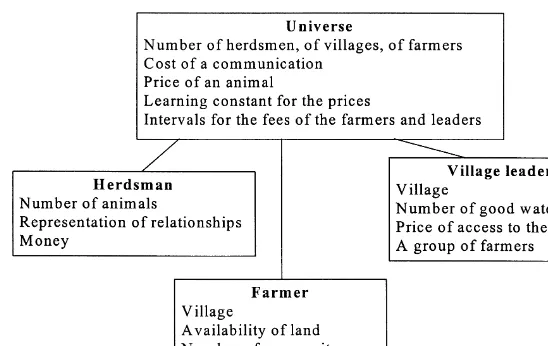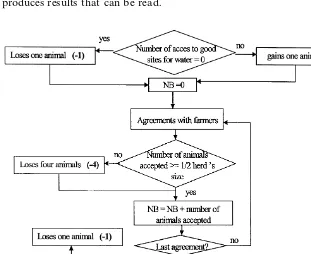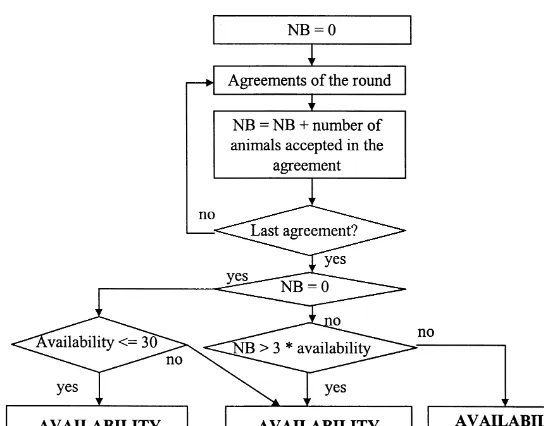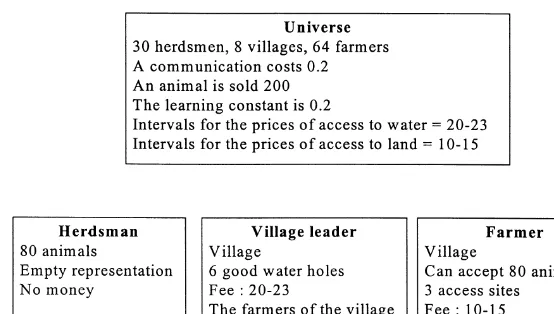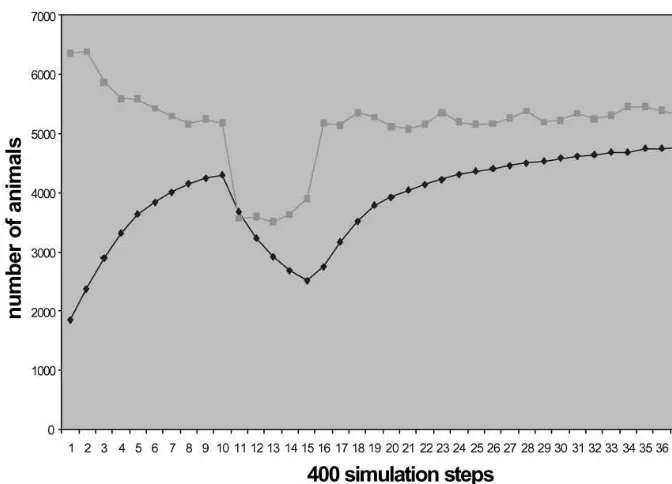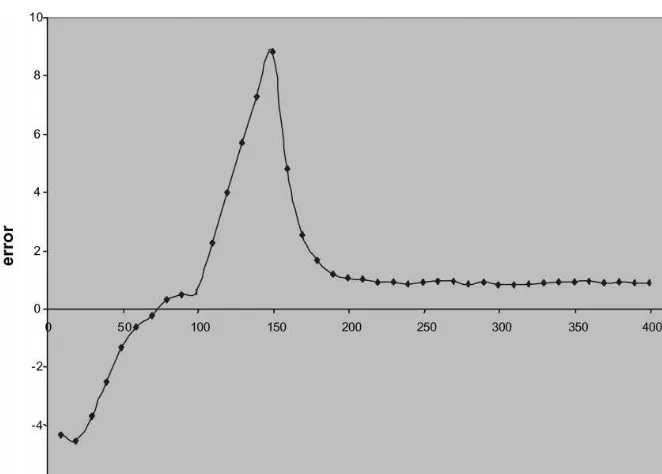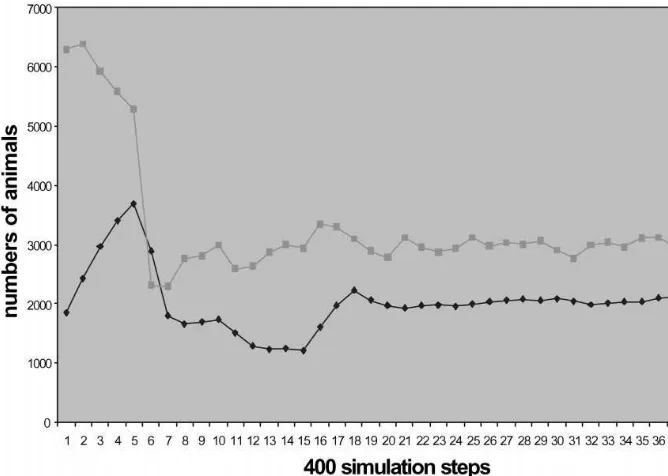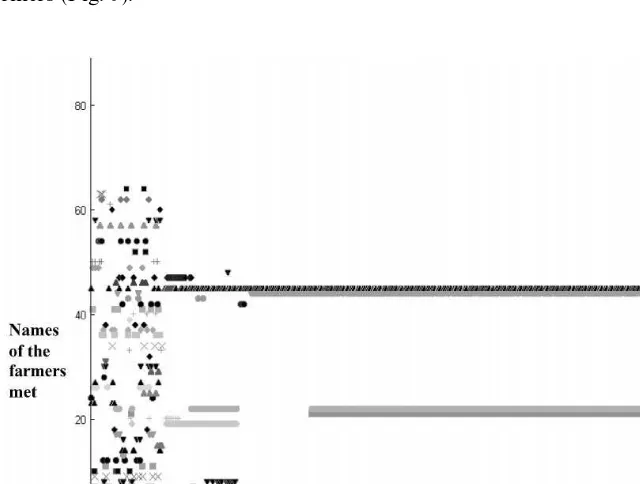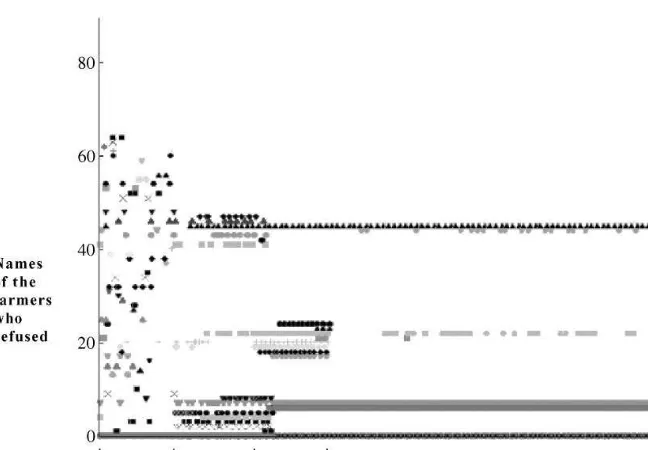25 (2001) 527}559
A multi-agent model for describing
transhumance in North Cameroon:
Comparison of di
!
erent rationality
to develop a routine
qJuliette Rouchier, Franc
7
ois Bousquet
*
,
Me
H
lanie Requier-Desjardins, Martine Antona
CIRAD-TERA, Campus de Baillarguet, BP 5035, 34032 Montpellier, France
Abstract
This paper introduces an application using multi-agent system to model an arti"cial society. The work follows a"eld research in economics in Cameroon about the behavior of nomad herdsmen securing their access to rangelands. Two central elements were stressed: regularity in meetings and#exibility while facing problems. Experiments run through simulations, testing two rationales: choices based on the notion of cost, or herdsmen taking into account the history of meetings. The system successfully shows regular dynamics, and huge di!erences are observed, depending on the rationality used. We conclude on the importance of the rationality described in modeling a system. ( 2001 Published by Elsevier Science B.V. All rights reserved.
JEL classixcation: C63; Q24; B41; C99
Keywords: Exchanges; Modeling; Pastoralisme; Familiarity; Economics
q
The authors wish to thank the Direction Scienti"que of the CIRAD for funding that research and Olivier Barreteau, Jean Boutrais, Jim Doran, David Hales, Scott Moss, Christian Mullon, Martin O'Connor, Alain PaveH and Jacques Weber for the precious comments they made of our work, on di!erent occasions.
*Corresponding author. Tel.: 33-4-67-61-58-00; fax: 33-4-67-59-38-27.
E-mail address:[email protected] (J. Rouchier).
0. Introduction
The model was built as part of a study on cattle transhumance in the extreme North of Cameroon. What is usually considered as the great strength of the transhumance practice is that it gives a great #exibility to deal with ecological uncertainty (Monod, 1975). The economic analysis is based on
a"eld study of the conditions that determine the access that nomadic herdsmen
have to pasture. It showed that both grazing patterns and the individual relationships established between the herdsmen and the local people are very regular (Requier-Desjardins, 1997). The model reported here is used to analyse that regularity by simulating the dynamics of the relationships between herdsmen and farmers, taking into account the two elements of regularity and #exibility. The tool that was used for modelling is inspired by distributed arti"cial intelligence (DAI) and is called a multi-agent system (MAS), regarded as very e$cient to model interactions and representations of agents.
The aim of this article is to describe the simulation experiments that were run to investigate characteristics of agent cognition that will generate the observed regularity of the relationships among the agents. The agents were implemented with very limited capacities to learn, in order to concentrate on our ability to demonstrate how the empirically observed regularities of interaction results from the repetition of local actions based on local under-standing.
In this article we"rst present the issues that were at the center of that research: the regularity of encounters of the herdsmen and di!erent analysis that can be done of that regularity in economics. Then we describe the tool that was chosen to study it, the multi-agent system, and its use to perform simulations in social sciences. Then we describe the three variations of the model built and the results of all the basic simulations performed. A more speci"c study of the parameters that in#uence the results of the simulations based on costs (called&cost priority'), helps to understand better the speci"city of its dynamics and compare it to the other one (the&friend priority').
1. Multi-agent modelling of transhumance in North Cameroon
1.1. Transhumance and decision
In North Cameroon, only herdsmen traditionally own large herds of cattle. The animals need to be fed and watered every day. In the dry season, herdsmen have to leave their usual homes to go in search of places that have su$cient forage and water. This seasonal mobility is called transhumance (Boutrais, 1978). When the herdsmen are away from their home village, they live in the bush. This space is a common property: it is not privately appropriated and anyone is allowed to use the resources that are on it. It is thus said to be on open access (Hardin, 1968). But one can notice that herdsmen are not actually free to graze their cattle wherever they please. Although the land seem to be open, there exist unwritten rules that de"ne how these&commons'should be used, although the land seems to be open (Ostrom, 1990). In the context of North Cameroon, the head of the village is responsible for the presence of the herdsmen, who are expected to announce their arrival to the village leader. If tradition has it that the village leaders never refuse access, it is equally habitual, if not compulsory, for the herdsmen to o!er money (Nicolas, 1986).
Quite regularly, the breeders have to sell an animal or buy some rice. This is why numerous economic exchanges (gifts, loans or guarding services) occur between the herdsmen and the sedentary populations, which are made up mainly of farmers. When relations are well established, manuring contracts are developed whereby sedentary farmers allow herdsmen onto their private land (Spencer, 1973). Some of the relations that take place between farmers and herdsmen require a huge level of trust between the actors. These trust relations seem to help normalize relations with the local people who also use the bush, particularly in the face of the risk of environmental degradation due to overgraz-ing. Most of these relations are quite regular and it is possible to show that this regularity is very important for the organization of the herdsmen (Requier-Desjardins, 1997; Rouchier and Requier-(Requier-Desjardins, 1998). A further problem is the frequent lack of water, preventing the herders from feeding their animals there. Thus, the regularity is also in#uenced by the state of the resource in the villages, and the herdsmen do adapt to that fact.
To study the regularities that appear in that context, it seemed to be interest-ing to analyse them takinterest-ing an economic point of view. That theory gives us a few tools to see what kind of rationality can explain the behaviors.
cost'(Williamson, 1994). Another interpretation does not accept the reduction of all aspects of transactions entirely to economic. All the institutions that appear around the exchange activity have a value that is more social or political, and has to be studied in themselves (North, 1990).
Since the herdsmen seem to have some very important habit for their ex-changes, it is interesting to study the reproduction of these exchange links. There can thus be two interpretations, that correspond to the di!erent economic models. The"rst one is based on the idea of cost where the agent is interested only in the cost of the transaction. The second one regards the relation as important in itself and includes the history of interactions (Greif, 1989) that builds the image each agent has of the others (Rouchier and Requier-Desjardins, 1998).
1.2. Multi-agent modelling
The approach that has been used to describe our model is usually described as the agent-based methodology for modelling (Epstein and Axtell, 1996). The aim is to be able to see global situations appear while describing the actions of the agents in a decentralized way. The choice was to use a multi-agent system to build the model: this tool is a form of computer modelling which is commonly used to build arti"cial societies for simulating di!erent situations (Conte and Gilbert, 1995).
In these systems, agents are autonomous entities, situated in a given environment (made up of other agents and a resource) which they can act upon (Ferber, 1995). They have objectives, their actions are governed by certain rules and they have the capacity to perceive their environment. In order to achieve their objectives, they interact and communicate with other agents (Rao and George!, 1995).
The advantage of this type of modelling is that individual relationships can be quite simply taken into account over time (Bousquet et al., 1998). Agents usually act on the basis of more than one set of criteria at a time, that can come from the resource, the history, the social and spatial situation of the agent. The descrip-tion of a system usually lays on four important quesdescrip-tions:
f what is the environment of the agent?
f what is the agent (what can she do and perceive from that environment?)? f what kind of interactions exist between the di!erent agents?
f what is the organization of the society (how is decided the order of the action?)?
for patterns on a macroscopic level for a combination of all of these factors (Ferber, 1994).
How to represent the agents is thus a key question in building a system. One can choose between two di!erent approaches, depending on the objectives of understanding (Kayser, 1992):
f It is possible to develop an accurate imitation of the mechanisms involved in the agents'relationships and in their capacity to learn. Simulations are then conducted to see whether the model can produce results that are comparable to observations from real-life situations. This is a method that is currently used in social sciences to "nd ways to validate models (Barreteau, 1998; Rouchier et al., 1998). In economics, one can"nd for example multi-agent models describing industries in the wood trade, where di!erent behaviours of agents are tested, as well as di!erent models of communication and control in the society (Antona et al., 1999).
f On the other hand, one can choose to put aside representational or relational models and try to "nd the minimum model for individual behaviour that would bring out the desired situations on a global level (Drogoul, 1992; Doran et al., 1994; Doran, 1998). This choice can be made to study di!erent patterns that stabilize when one considers the society as an evolving system (Arthur et al., 1997; Hales, 1997; Rouchier and Bousquet, 1999).
We chose that last approach in building the model, since we choose very few elements of the description of the life of the herdsmen to build our society: oriented the work towards getting some very speci"c results while using just very simple descriptions of the rationality (Treuil, 1995).
Several economic and sociological studies have already been carried using that methodology of emergence seeking. A famous example is the one of Epstein and Axtell, who studied the society&from the bottom up'(Epstein and Axtell, 1996). They initiated very simple local behaviours in their agents, giving them the ability to use a resource, exchange goods and ideas, and then studied the apparition of a whole economy, migrations, taking over of a population. The relation of the agents to the resource has already been studied deeply on the subject of pastoral activities, considering the evolution of the behaviour along the time, using the idea of adaptation (Bah et al., 1998; Bousquet et al., 1999). Hence, the use of multi-agent for simulation gives the opportunity to use the idea of virtual laboratories, using the idea of evolution: arti"cial life concepts reveal themselves to be quite analogous to economic ones (Tesfatsion, 1997).
possible to postulate real complex rationality in the behaviour, when one takes the agent-base point of view. For example, the prisoner's dilemma can be reanalysed, by building a whole society where the existence of reputation gives to the agents the opportunity to choose who they want to interact with. That approach shows the emergence of new stable strategies that could not be expressed by usual interaction descriptions (Stanley et al., 1994).
2. Model and objectives
The aim of our research was to analyse the di!erence of patterns of relations that could be created simply through merchant exchanges, in an arti"cial world that captures the situation of herdsmen trying to have access to a resource over time. Thus we implemented an arti"cial society with three populations, one mobile population and two o!ering services. The rational abilities of the agents were restricted so that the only kind of agent interaction is a dialog between an arti"cial herdsman who proposes a deal to an arti"cial farmer, who answers. To build the agents' logic, the inspiration came of the economic points of view previously describer, and two ways of reasoning were implemented for our agents: one inspired by the idea of cost, and the other by the idea of institutions.
Since we wanted to generate regularities in relationships, the choice was to decide that the farmer who expressed a refusal would be made somehow unattractive. This was translated, using no more than the minimum cognitive processes:
f To capture the idea of costs: any refusal is integrated by the herdsman as an extra-cost anticipated for the new transaction.
f To capture the idea of a value in the relation: the herdsman remembers the refusals and the agreements made by the farmers.
To keep close to the evidence that inspired us (the life of the herdsmen in Northern Cameroon), we considered in the simulations that there are some disruptions that limit the resource. The e!ect on the relations is that, during a short period, the farmers have to reject systematically the proposals of the herdsmen. Running the simulation, we compare the patterns that are obtained in relations and the e$ciency of the use of the given resource. Di!erent relation-ship yield very di!erent results.
3. Introduction to the multi-agent model
Fig. 1. Three classes of agents belong to the arti"cial Universe.
as economic-type exchanges, even when the representation are not all based on costs.
We put together three classes of agents (Fig. 1). The"rst population represents herdsmen who need the grass and water and request access by making proposi-tions. The second represents the village leaders who accept the presence of the herdsmen by providing good or poor access to water depending on their order of arrival. The third is that of the farmers who are grouped together in villages under the responsibility of the village leaders and who own land that they may allow herdsmen to graze.
3.1. A round or&simulation step'
During one unit of time, the herdsmen"rst choose which leaders they are going to approach and then which farmers to approach in the corresponding villages (Fig. 2). They then sell an animal if they do not have the means to spend the maximum amount of money on a round. After that, they send their proposi-tions for access to the leaders and the farmers, respectively. The leaders reply, then the farmers reply and the money circulates. The herdsmen do an appraisal and change their representations as a function of the replies they received.
3.2. Costs and representations
Fig. 2. A simulation step.
whatever the herdsman o!ers for a poor site. All the farmers'and village fees are included for a given interval. In order to pay for access, the herdsmen sell animals at the beginning of each round. The herdsmen are equipped with a representation of the other agents. The farmers and their leaders are all represented in the form of an access fee. When herdsmen propose agreements they o!er the relevant access fee when they know what it is, otherwise they o!er an arbitrary amount that is within an acceptable range. To start with, the herdsmen do not know the value of any of the access fees. When a farmer accepts an agreement or when a village provides access to a good site, the herdsman registers the cost of the transaction as a representation of the other agent. Any time the herder receives a refusal from an farmer or when a village provides access to a poor site, the representation (the access fee he is willing to pay) changes: it is increased by the&learning constant'. The herdsmen also remember
the&quality of the relation'which is:
number of good accesses-number of bad accesses (for a leader), (1.1)
number of proposal accepted-number of refusals (for a farmer). (1.2)
3.3. Propositions made by the herdsmen
graze their animals. When they"rst arrive they go straight to the village leader with a proposition and pay him the amount agreed. They then ask two farmers for access and the farmers are also paid if an agreement is reached.
In the experiments described here, there are three possibilities available to the herdsmen for choosing which village leaders and farmers to ask for access:
f The"rst option is to choose randomly from each of the populations. In this
way the herdsmen can make contact with all the village leaders and then with all the farmers in the corresponding villages.
f The second option is to choose the&cheapest'village, and address a demand to its leader. The imagined cost for a village has a value of:
Village price"the leader's fee#2 (average of representations of
the known farmers of the village).
(2)
Once the villages with the lowest fees are chosen, then the herdsmen choose the cheapest farmers in each village. As the herdsmen do not know the fees a priori, when they make this choice they can only ask the agents that they already know.
f The third option is to choose the village where he had the largest excess of compared over refusals. The global indicator for the village is
Village's indicator"(&quality of relation' with the leader)
#(average of&quality of relation' with the
farmers of the village). (3)
Then he addresses the leader, and in the village he asks the farmers that have the highest quality of relation.
3.4. Answers from leaders and farmers
The village leaders have a"xed number of good sites to o!er. These are given to the herdsmen in their order of arrival. The farmers can o!er access to three good grazing sites if they have su$cient land available, otherwise they only have one access to o!er. When a farmer accepts the terms of an agreement, he allows a certain number of animals onto his land:
f if there is more than enough land available to accommodate a given herd, the farmer o!ers all his available land
Fig. 3. Conclusion of a round for a herdsman. 3.5. Conclusion of a round
At the end of a round, the herdsmen assess the agreements that have been made and this can be translated as an increase or decrease in herds size (Fig. 3). The farmers consider the evolution of their available land (Fig. 4).
4. Description of the simulations
4.1. Initialization
Initialization is the term given to the process of setting a number of para-meters to de"ne the arti"cial world. We based our model on two types of results in order to make the initial choices:
f "eld data which restricted herds to a certain size and de"ned the number of
access sites required by the animals,
Fig. 4. Conclusion of a round for a farmer.
In order to achieve this, we decided:
f to ensure that the model had enough land and potential access sites so that a priori the herdsmen would not be&competing' for access
f to limit the number of agents.
The choices made can be seen in Fig. 5. All the farmers are given the same amount of land to begin with. This represents the maximum amount of available land that a farmer can o!er over time. Each leader can o!er the same number of good access sites for water. The access fees are drawn arbitrarily for each leader and for each farmer and they do not change over time. They are randomly chosen within a de"ned interval at the start. All the agents know the interval, but the price is individually known.
4.2. Dexnition of the simulations
Fig. 5. The initialization for the basic simulations.
This is what we will refer to as the&wave of refusals'. In all simulation, if no order is speci"ed, the herdsmen request access in a random order on each round.
4.3. Random simulations
These simulations are used as a reference to study the function of the system that we have set up. Here, all the choices made by the herdsmen, whether for access to water or land, are random.
4.4. &Cost priority'simulations
We then study how an objective of least expenditure could lead the agents to set up meeting routines. As the agents have no prior knowledge, they would be unable to decide because these choices presuppose that they have met the leaders and farmers at least once. Thus, for 50 rounds the choices made by the herdsmen, whether for access to water or land, are random. After the 50th round the proposals are made towards the cheapest farmers in the cheapest villages. Since these are the simulations that we are mostly interested in, we conducted di!erent simulations with this protocol. We will study in those the &learning periods': when the agents have to adapt to new situations (changes of logic or the resource being disturbed). Therefore, the two parameters that in#uence the comparative evaluation of the places and agents need to be considered:
f the maximum di!erence between leaders'prices, f the learning constant.
4.5. &Friend priority' simulations
We study how the agents react when their objective is to go and visit the agents that accepted the most of their propositions. Here, they have no repres-entation at the beginning, hence for 50 rounds the choices made by the herds-men, whether for access to water or land, are random. After the 50th round, the proposals are made to the farmers and the villages with the highest value of quality of relation.
4.6. Observation
Production: We observed the evolution in the total number of animals as well as the number of animals in each herd. We are interested in the di!erence between the herds at the end of the simulations. What we also consider is the total amount of available land of the farmers.
Meetings: For each round, we observed the number of farmers who were not approached with a proposition. For one unit of time, a meeting is considered to be regular if two agents have reached three agreements on the previous 10 rounds. For a simulation, a relationship between a herdsman and a farmer is considered to be constant if the two agents have reached agreements on more than half the rounds from the 50th round onwards. A relationship is considered stable if the two agents interact on more than 50 consecutive rounds. We are also interested in the same criteria applied to the refusals. In this dynamic, we
call &competition' a situation where too many herders go and ask the same
farmers at the same time and then receive refusals.
Learning: We observed the error of evaluation of a herdsman, as indicator for determining the herdsmen's capacity to learn. It is the sum (for all the farmers he knows) of the di!erence between its representation and the real price of the farmer. We look at the average total for the whole herdsmen population. Since the representation changes at every time step, this indicator varies.
5. Results:Development of the simulations
In order to obtain results, we conducted series of 200 simulations each lasting 400 units of time. The results reported here are typical for each type of simulation. A great regularity was indeed observed in those results.
5.1. Random
Fig. 6. Number of animals that can be accepted on the land (availability) and number of animals that survive globally when the herdsmen choose randomly.
a di!erence of no more than 40 animals between the largest and the smallest herds. The amount of available land each farmer has varies constantly over time. It can decrease to 27 and then go back up to its original value. Overall, the total amount of available land decreases from 5200 to 4700. From the 70th unit of time onwards this value oscillates slightly but always remains greater than the number of animals. After 100 rounds, half of the farmers refuse all the access requested for 50 rounds. At that moment, the number of animals is about 3500 and decreases during that period down to 2000. At the end, the number increases again, and goes back to the same situation as before. It takes 70 rounds to reach 4000 beasts. The di!erence of size between the biggest and smallest herds varies a bit, and is always less than 45. The availability of the land falls and goes up again as soon as the farmers stop refusing all the propositions.
Fig. 7. The global error in the representation of the herdsmen when they choose randomly the accesses.
round. There are 0}12 herdsmen per village at any one unit of time, with an average of six.
Learning(Fig. 7): As meetings occur, the herdsmen's proposals are accepted or rejected. In this way, their representations of the farmers evolve. Results show that the total error re#ects a slight overestimation of the real prices during the period when the farmers accept normally. It is on average less than 0.1 for the knowledge of a price. During the wave of refusals, the error of the herdsmen increases a lot, but decreases very quickly as soon as the period"nishes. It can also be seen that the herdsmen know the exact values of about 50 of the farmers'prices.
5.2. Cost priority
For all of the&cost priority'simulations, one can detect two periods during which the herdsmen have to get used to new habits, corresponding to the moment when a large number of refusals in#uence the choices made by the herdsmen. They correspond to two events implemented in the system:
f the "rst is the abrupt change from a situation where the herdsmen meet
Fig. 8. Number of animals that can be accepted on the land (availability) and number of animals that survive globally when the herdsmen choose with&cost priority'.
f the second is the period of disruptions when farmers are suddenly no longer able to grant access to herdsmen: we refer to it as the&wave of refusals'from the farmers (at step 100).
Fig. 9. The farmers met by a herdsman who chooses with a&cost priority'. The farmers'names are numbers that are grouped in villages. Each time an agreement takes place, it is represented by a spot: one sees that the herdsmen do not go to all villages.
usually lose all their animals. Land availability falls to 2000 because of the lack of animals and then rises again a little in the period of adaptation. It falls again in the next period, to increase slowly as soon as the farmers accept some herdsmen again.
Meetings: In the intermediary period of 40 units of time, there is what we call
the&learning period'. At the beginning, all the herdsmen go to the same farmers.
Fig. 10. The farmers who refuse the access to a herdsman who chooses with a&cost priority'. Each time the answer of the farmer is a refusal, it is represented by a spot: when the farmers refuse systematically the access, the herdsmen keep going to ask very regularly and change rarely their choice.
Fig. 11. The global error in the representation of the herdsmen when they choose access with&cost priority'.
high, and who now receive new requests very regularly. The number of regular relations (Fig. 9) drops during the refusal period and gets up again after this period, not reaching the same level. Here again, relationships have been trans-formed a great deal by the period when herdsmen met with a lot of refusals. However, once this period is over the system readapts extremely quickly. It is possible to observe the great regularity of the herdsmen's relations on the "gures.
because their fee is much too high compared to the others. After that period there is a sort of stability: the herdsmen regularly go back to see the same farmers. Their behaviour is constant, although the agreements are not: they still receive some refusal from the farmers they always go and see. Usually, the increase of representation is then not enough so that they change their choice for the next round, and their representation goes back to normal as soon as they have an agreement accepted with the usual farmer. During the wave of refusal, the herdsmen's total margin of error has increased again and remains higher once this period is over. Each de"nitive increase in this margin of error is a sign that the herdsmen do not go back to see farmers and that their representation of the farmers remains overestimated. In addition, the number of farmers that are well known drops overall. At the end of the disturbances, the herdsmen sometimes return to the very cheap farmers, but since some villages are de"nitely ignored, no requests are made to the farmers in them.
5.3. &Friend priority'
Just as in the previous simulations, there are two phases when the system loses stability, which are the adaptation phase and the wave of refusals.
Production (Fig. 12): The situation is the same after 50 rounds as in the preceding results. The number of animals does not drop too much in the case of that new way of choosing, and neither does the availability of the land. It is stabilised very quickly. There are about 3600 animals after 30 rounds (120 animals per hard). When the farmers begin to refuse the herdsmen, the number of animals decreases a lot, but comes back to normal as soon as this period has stopped. The di!erence of size between the herds gets to 70 during the period of refusals and gets down afterwards. It gets up again all along the simulation to reach that maximum value again. The availability falls a little when there is the change of choice for the herdsmen, and then really falls during the refusal period.
Fig. 12. Number of animals that can be accepted on the land (availability) and number of animals that survive globally when the herdsmen choose with&friend priority'.
priority'simulation. At the end of the period, the patterns in the relationships have not changed. On the whole, the number of regular relations are a little bit higher than in the&cost priority'simulation.
Learning(Fig. 15): During the"rst period of change, the image of the cost does not increase as much as in the former kind of simulation. This is due to the fact that the herdsmen go and see regularly more di!erent farmers and thus know
the&real'fee of a bigger number of them. The herdsmen's total margin of error
increases a lot during the refusal period. It remains higher than in the case of
a&random'simulation, but is still quite low at the end of the simulation since the
herdsmen have come back to see those who refused a lot, even when they think their price is high.
5.4. Synthesis
Fig. 13. The farmers met by a herdsman who chooses with&friend priority'. Each time an agreement takes place, it is represented by a spot: here one sees that the herdsmen go and see farmers that are in all villages.
our simulation, is that in the world created, the choice that makes the more animals survive is the one at random. The repartition of animals is also more even with the random simulation than with the others. In the two other kinds of simulation, the regularity that is created induces regular meetings on the same land, and thus a kind of competition. That concurrence is anyway much less important with the&friend priority'logic than with the other. What it reveals of the system is that it is very sensitive to the distribution of the herdsmen on the land, and thus imposes to the arti"cial agents the kind of constraints that can be observed in the real world. In that context, the regularities that are created are really very interesting. Out aim is not to analyse right now the di!erences between the simulations with regularities, but to study more precisely the&cost priority'simulation which is the one that interests us the most.
6. Further results about the&cost priority'model
Fig. 14. The farmers who refuse the access to a herdsman who chooses with&friend priority'. Each time the answer is a refusal, it is represented by a spot.
Fig. 15. The global error in the representation of the herdsmen when they choose accesses with
Fig. 16. Number of animals in the universe after 400 simulation step, depending on the learning constant (from 0.1 to 2). The average is taken on 50 simulations here: the results are not directly correlated to that number but there is a clear in#uence.
"gures increase slowly and stagnate quickly, never getting back to the pre-ceding values. During the same period, the error in representation increases very quickly, and never comes back to its former value. One has to remember that a very high error in representation for a herdsman means that he has made a de"nitive choice regarding one of the farmers and that he never goes back to see it. Those two periods should actually be called &error creation' period. This time lapses have such considerable in#u-ence on the future of the simulation that we went on to study this period, by analysing di!erent factors in it. We studied two parameters that in#uence the learning and its speed: the learning constant and the di!erences of prices between the leaders.
6.1. The learning constant
to be 15 (maximum value). The variation in this parameter has a major in#uence on the agents' rate of learning. It also has an e!ect on the number of animals: the higher this constant, the better the animals globally survive. At the same time, one notes that the di!erences between the herds do change too, depending on that constant: there is more inequality in the repartition when the constant increases. Actually, the number of animals is higher in the simulations with a high learning constant not because all the herds get bigger but because a few do, which explains why the correlation is not very impor-tant, but that a tendency can be observed (Fig. 16). At the same time, the error is highly dependent on this constant, and increases much quicker if it is higher (which is logical). Actually, the systems behaves as if the survival of the herdsmen was linked to the error they make. We understand it as the way the relationship organize and get secured, so that the competition can be avoided.
A quite important result appears here, which is that our model makes it impossible to have at the same time good information and good survival of the herds. The competition, due to the fact that the agent should be interested in meeting the same farmers when they know the right fees, is minimized only by the error that the herdsmen make in evaluating the price.
6.2. Price diwerentials between the leaders
We noticed during the simulation that the change of habit from a village to another is the most di$cult thing for a herdsman. When a herdsman receives refusals from the same farmer, with no acceptance, the representation he has increases a lot. In the two periods with a lot of refusals, some of the representation get to 15 very quickly. But what is to be noticed is that some herdsmen do not change village although they are in such a bad situation. It is possible to understand because the representation of the cost of a village is based on the fees of the farmers AND the fee of the leader. A herdsman will go to another village only if the average value of the imagined prices is su$ciently high compared to the other villages. If he already overestimates the farmers in the other villages or if the fees of the leader is too high, he will not necessarily want to change.
Table 1
Results after 400 simulation step, depending on the maximum di!erence of fees among the leaders (average for 50 simulations*maximum and minimum are given for the number of animals)
Global No. of Di!erence Global error number of herds between the for the
animals biggest and herdsmen
For each herdsman, what is a real question in the&cost priority'simulations is
to"nd an equilibrium between two characteristics:
f to be able to change places quickly enough to"nd new land that can support him,
f to be able to overestimate the farmers quick enough so that to create its own point of view, di!erent from the one of the others, and thus avoid competition.
Fig. 17. Global number of animals for several simulation where the di!erence of fees among the leaders varies: the number of animals depends on the ability for the herdsmen to change their choice.
7. Discussion
In our arti"cial world, we managed to establish a regular pattern of relations for the agents, by giving the instruction to avoid refusals to the agents. This ability to choose was based on two models of representation of the history of their relations. In the"rst model, the agents have only one way to understand their relations with the farmers, and only consider the dimension of costs. In the alternative representation, the herdsmen remember the number of successful agreement and of refusals they received. This ability to choose captures the importance to the herdsmen of stable relationships.
7.1. Results of the simulations
The"rst di!erence that can appear in the two models is the one of production
Table 2
Global production for each simulation
Random Cost priority Friend priority
Number of 4902 2280 4646
animals
Availability of the 5231 3046 4810
land
between the 50th 64 20 27
and the 400th simulation steps
but the e$ciency of the&cost priority'model is surprisingly low compared to the
&friend priority'one. In some settings, there is even disappearance of some of the
herds in the&cost priority'model, whereas the&friend priority'shows individual and collective results that are almost as good as in the random simulation, which served as a reference.
The reason for that situation seems to be found in the fact that the &cost priority'representation creates a very important competition among the herds-men. Actually, it is the only model where all herdsmen are supposed to share interest for the same farmers. The&cost priority'model of representation is a way to integrate both objective and subjective elements of knowledge for the herds-men: it is built through meetings taking into account the&real'price as well as the refusals. The other model is purely &subjective' for each herdsman, since the agent only cares about the relations he had with the other.
To adapt to constant refusals, the agents have to change their representations so that to choose new place. But since they have no understanding of the phenomenon of competition, they do not avoidspecixcallythe place where a lot of herdsmen go, and still get to place that are only&satis"cing'for them (Simon, 1991). There is thus competition during the whole simulation, that makes the production quite low.
What we also see here is that competition has a bad impact on the production, which is an assumption that is often put forward by the people who try to create arti"cial societies (Conte and Gilbert, 1995).
very constant and have no ability to change quickly from one place to another. If ever they change their choice once, it is for good and they never come back. What can explain this is the fact that a herdsman forgets all the refusal that a farmer made just when the other accepts one proposition: at that moment it learns the real fee and loses the information that where kept in memory through the cost. This inability to remember the accumulation of refusal is the reason that makes its memory less adaptive when agents get more refusal: its point of view changes to quickly. On the opposite, the &friend priority' model induces a representation that is more#exible for the agent. In this representation, one single refusal can never make the herdsman never go back to see the farmer. This is what can explain that the herdsmen have several regular relations in the &friend priority model', and oscillate between them. The regularity is thus less constant than in the other kind of simulation.
7.2. Model and theory
We shall here compare the two models we used to create those regulari-ties and see how their di!erences relate to the realiregulari-ties of the theory and of the herdsmen situation. Of course, the model pictures a society that is very far from the real society, but the essential pieces that we wanted to develop are in:
f we supposed no communication among the agents other than the merchant exchanges: only acceptance or refusal of the deals proposed are used, f that choice was made to achieve simplicity without distortion in the
descrip-tion of the observed social reladescrip-tions. To achieve that aim the memory of the agent was quite simple,
f both speci"cations were inspired by a theoretical view of the interactions: the idea of translating risk as an increase in price anticipation came from transaction cost theory; the idea of having the link reproduced, caring more for the description of real practices was closer to the neo-institutionalists' approach.
f as a consequence of the previous assumption, dynamics processes and interac-tions were emergent phenomena.
1One of them being the necessary reproduction of links in di!erent places, that ensure the nomads that they will be able to change routes whenever it is needed.
In both models the dynamics of the land and the animals were well depicted since a pretty good correspondence was found between those elements. But the equilibrium that was found between these two elements were not the same. Both situations could show situations of competition among the agents due to regularity, that could be interpreted as externalities, each action of one agent being a bother to the others. In that case, the&cost priority'point of view for the agent was very bad for the system: the way the agents learn is not#exible enough so that they should be able to change their relation when numerous other agents are on the same land. This is quite interesting when one wants to discuss what is regarded as an essential element of the use of the pastures: the carrying capacity. There is usually considered to be an optimal number of animals that can be put on a land so that the grass is not destroyed over the years. That number is calculated as a property of the"elds. What the model shows is that, for the same resource and the same local reaction to use, very di!erent global results can emerge. Consequently, the carrying capacity seems to depend on social practices as well as ecological facts. That results helps to reinforce a recent point of view from developers who try to show that notion should never be used to discuss access to land to nomads, since their whole system is aimed at adapting to very tough and changing ecological conditions. The way the resource is used should be considered taking into account the numerous objectives of the people1
(Behnke and Scoones, 1992).
A sort of paradox appeared while running the simulations. The societies that exhibited the highest"delity as a global behaviour were not those based on the repetition of satisfying interactions but the ones based on costs. This is quite interesting, since the choices based on links, much closer from real actions of people, also produces the patterns that resemble the most the observations of the real behaviours. In their everyday choice, the nomad breeders are very careful of reproducing links and having a lot of friends in sometimes far places. In the Sahelian zone, the climate changes locally from one year to another and implies huge changes in the use of the resource. When they have to change places, the nomads still have to undergo exchanges to get some food, and information to know what to do. The only way for them to have a nice everyday life is to be able to rely on a lot friends. And this is why an extended social network is a very important feature for a nomad (Monod, 1975). The only simulations that reproduced relations that can be recognised as diverse and as regular were those based on&friend priority' relations: less stable, but in every village, and rea$rmed more than once every 10 simulation step.
the idea that agents maximize over a utility function when they decide on their actions. This unique function is usually a translation of several di!erent factors, that it seems to be accurate to reduce to one. The argument that we choose here to justify our translation, is the fact that a refusal could be seen as a loss for the agent. To change directly the rationality however has a great impact on the way the memory of the agent evolves. If the cost represents the way the agents understand the world, this can erase the in#uence of familiarity. What the Section 6 showed is that even a lot of di!erent tests made to change the dynamics of learning could not change the usual patterns of behaviour.
Obviously, in a context where regularity is a key element of choices, it is very important that familiarity could be taken into account in any model built: here this is the case only when history is not forgotten. Our results demonstrate that a description of rationality based exclusively on costs is certainly not appropri-ate in relation to most social and economical situations. This point is also made by some economists, either complaining about the standardised theories that experts exhibit to treat issues concerning nomads (TheHbaud, 1995); or more generally about the way complex practices are very often totally reduced by the economic approach (Moss, 1999; Kirman, 1997).
This point is all the more important because the multi-agent system approach revealed itself very e$cient for modelling, simulating, and observing an arti"cial world where interactions are crucial. Whereas it is still regarded as very di$cult to express the same issues in classical economics models (Parunak et al., 1999). The emergence of structures that"t descriptions of the real world was possible to observe, on a basis of a local description of actions. This is quite interesting since many economic situation are based not only on a utilitarian rationality, but also on the prevailing social network, as it is often pointed out (Freeman et al., 1989).
References
Antona, M., Bousquet, F., Le Page, C., Weber, J., Karsenty, A., Guizol, P., 1999. Economic theory of renewable resource management: a multi-agent system. In: Sichman, J., Conte, R., Gilbert, N. (Eds.), Multi-Agent Systems and Agent-Based Simulation, Lectures Notes in Arti"cial Intelli-gence, Vol. 1534. Springer, Berlin, pp. 61}78.
Arthur, W., Durlauf, S., Lane, D., 1997. The economy as an evolving complex system, II. Santa Fe Institute Studies in the Science of Complexity. Proceedings, Vol. XXVII. Addison-Wesley, Reading, MA.
Bah, A., Canal, R., D'Aquino, P., Bousquet, F., 1998. Les SMA geHneHtiques pour l'eHtude de la mobiliteH
pastorale en zone intertropicale humide. In: Proceedings of SMAGET, CEMAGREF, Clermont-Ferrand, pp. 291}302.
Barreteau, O., 1998. Un systeHme multi-agent pour explorer la viabiliteH des systeHmes irrigueHs: dynamique des interactions et modes d'organisation. Ph.D. Thesis, ENGREF, Montpellier. Behnke, R.H., Scoones, I., 1992. Repenser l'eHcologie des parcours: implications pour la gestion
Bousquet, F., Bakam, I., Proton, H., Le Page, C., 1998. Cormas: Common-Pool Resources and Multi-Agent Systems. Lecture Notes in Arti"cial Intelligence, Vol. 1416. Springer, Berlin. Bousquet, F., D'Aquino, P., Rouchier, J., Requier-Desjardins, M., Bah, A., Canal, R., Lepage, C.,
1999. Rangeland herd and herder mobility in dry intertropical zones: multi-agent systems and adaptation, people and rangeland. In: Elridge, D., Freudenberger, D. (Eds.), Building the Future, of the VI international Rangeland Congress. Vol. 2. Townsville, Australia, pp. 831}836.
Boutrais, J., 1978. Deux eHtudes sur l'eHlevage en zone tropicale humide (Cameroun). Travaux et Documents de L'Orstom. no. 88. Orstom, Paris.
Conte, R., Gilbert, N., 1995. Computer simulation for social theory, introduction to: arti"cial societies. In: Conte, R., Gilbert, N. (Eds.), The Computer Simulation of Social Life. UCL Press, London, pp. 1}15.
Doran, J., 1998. Social simulation, agents and arti"cial societies. In: Demazeau, Y. (Ed.), Proceedings of the ICMAS 98. IEEE Computer Society, USA, pp. 4}6.
Doran, J., Palmer, M., Gilbert, N., Mellars, P., 1994. The EOS project: modelling Upper Paleolithic social change, In: Simulating Societies. The Computer Simulation of Social Phenomena. UCL Press, London.
Drogoul, A., 1992. L'eHthomodeHlisation, Rapport no. 92/20, Institut Blaise Pascal, Paris.
Epstein, J.M., Axtell, R., 1996. Growing Arti"cial Societies. Social Science from the Bottom Up. The Brookings Institution, Washington, DC, USA.
Ferber, J., 1994. La KeHneHtique: Des systeHmes multi-agents a` une science de l'interaction. Revue Internationale de SysteHmique 8, 13}27.
Ferber, J., 1995. Les SMA: vers une intelligence collective. Inter Editions, Paris.
Freeman, Linton, C., Freeman, S.C., Michaelson, A.G., 1989. How humans see social groups: a test of the Sailer-Gaulin models. Journal of Quantitative Anthropology 1, 225}238.
Greif, A., 1989. Reputation and coalitions in medieval trade: evidence on the Maghribi traders. The Journal of Economic History XLIX (4), 857}882.
Hales, D., 1997. Modelling meta-memes. In: Conte, R., Hegselmann, R., Terna, P. (Eds.), Simulating Social Phenomena. Springer, Berlin.
Hardin, G., 1968. The tragedy of the commons. Science 162, 1243}1248.
Kayser, D., 1992. Intelligence arti"cielle et modeHlisation cognitive: objectifs et eHvaluation. Intellec-tica 13}14, 223}240.
Kirman, A., 1997. The economy as an interactive system, In: The Economy as an Evolving Complex System, II. Arthur, W., Durlauf, S., Lane, D. (Eds.). Santa Fe Institute Studies in the Science of Complexity, Proceedings, Vol. XXVII. Addison-Wesley, Reading, pp. 491}532.
Monod, T., 1975. Introduction. In: Monod, T. (Ed.), Les SocieHteHs Pastorales En Afrique. Etudes PreHsenteHes et DiscuteHes Au XIIIie`me SeHminaire International Africain, Niamey, DeHcembre 1972. Oxford University Press, London, Ibadan, Nairobi, pp. 298}321.
Moss, S., 1999. Social simulation models and reality: three approaches. In: Sichman, J., Conte, R., Gilbert, N. (Eds.), Multi-Agent Systems and Agent-Based Simulation. LNAI Series. vol. 1534. Springer, Berlin, 45}60.
Nicolas, G., 1986. Don rituel et eHchange marchand dans une socieHteHsaheHlienne, institut d'ethnologie, Paris.
North, D.C., 1990. Institutions, Institutional Change and Economic Performance. Cambridge University Press, Cambridge.
Ostrom, E., 1990. Governing the Commons. The Evolution of Institutions for Collective Action. Cambridge University Press, Cambridge.
Rao, A.S., George!, M.P., 1995. BDI: from theory to practice. In: Lesser, V. (Ed.), Proceedings of ICMAS'95. MIT Press, Cambridge.
Requier-Desjardins, M., 1997. L'acceHs aux pa(turages, une approche eHconomique de la mobiliteH. In: Actes du colloque MeHga-Tchad, L'homme et l'animal dans le bassin du lac Tchad. Orstom, Paris. Rouchier, J., Barreteau, O., Bousquet, F., 1998. Evolution and coevolution of individuals and groups. In: Demazeau, Y. (Ed.), Proceedings of the Third International Conference on Multi-Agent Systems. IEEE, Los Alamitos, pp. 254}260.
Rouchier, J., Bousquet, F., 1999. Non-merchant economy and multi-agent system: an analysis of structuring exchanges. In: Sichman, J., Conte, R., Gilbert, N. (Eds.), Multi-Agent Systems and Agent-Based Simulation., LNAI Series, Vol. 1534. Springer, Berlin, pp. 111}123.
Rouchier, J., Requier-Desjardins, M., 1998. L'interdisciplinariteH pour la modeHlisation dans la Recherche-DeHveloppement. Compte-Rendu d'une expeHrience en cours, Une application au Pastoralisme Soudano-SaheHlien. In: Proceedings of SMAGET. CEMAGREF, Clermont-Ferrand.
Simon, H.A., 1991. Sciences des syste`mes. Sciences de l'arti"ciel. Dunod, Paris.
Spencer, P., 1973. Nomads in alliance. Symbiosis and Growth among the Rendille and Samburu of Kenya. Oxford University Press, Oxford.
Stanley, E.A., Ashlockv, D., Tesfatsion, L., 1994. Iterated Prisoner's Dilemma with Choice and Refusal of Partners. In: Langton, C. (Ed.), Arti"cial Life, III, Santa Fe Institute Studies in the Sciences of Complexity, Vol. XVII. Addison-Wesley, USA, pp. 131}175.
Tesfatsion, L., 1997. How economists can get alife. In: Brian Arthur, W., Durlauf, S., Lane, D. (Eds.), The Economy as an Evolving Complex System II, Santa Fe Institute Studies in the Sciences of Complexity, Vol. XXVII. Addison-Wesley, USA, pp. 533}564.
TheHbaud, B., 1995. Foncier, deHgradation des terres et deHserti"cation en Afrique: reH #exions a` partir de l'exemple du Sahel. Series Programme Zones Arides. no. 57, juillet. IIED, London.
Treuil, J.P., 1995. Emergence of kinship structures: a multi-agent approach. In: Conte, R., Gilbert, N. (Eds.), Arti"cial Societies The Computer Simulation of Social Life. Chapter 4. UCL Press, London, pp. 59}85.
